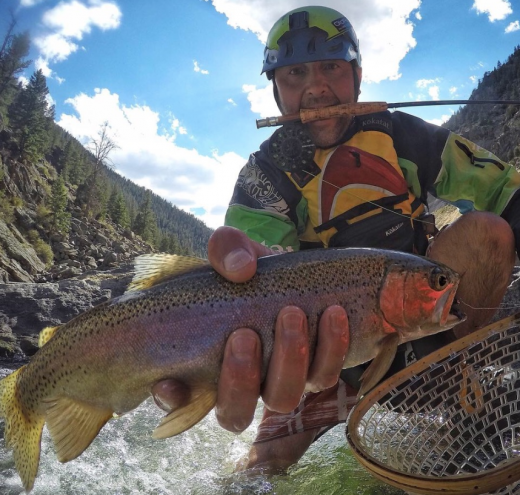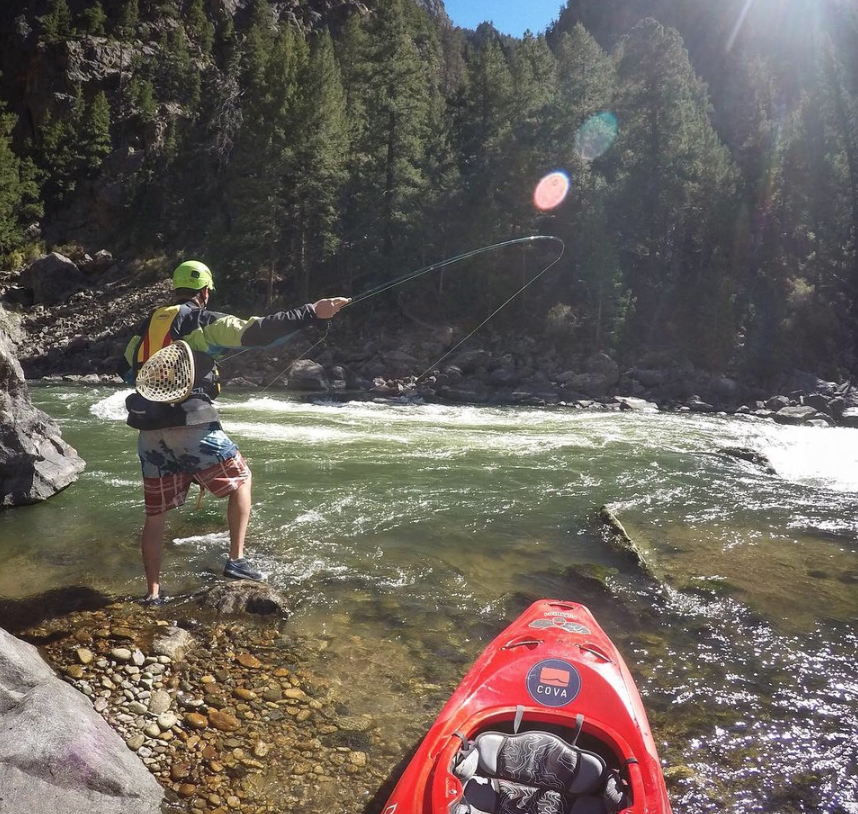By Scott Willoughby
They call it Fisherman’s Nightmare. And as scare tactics go, it’s as accurate as it is effective.
Floating into the chaotic jumble of rocks and water that serves as sentinel to the Colorado River’s daunting Gore Canyon, it’s easy to imag
ine how the rapids earned their name. Dropping precipitously from the placid, pastoral flats surrounding the Blue River confluence near the tiny town of Kremmling, Colo., the tumultuous drop marks the start of the steepest and most technically challenging whitewater of the entire Colorado River.
An unwary angler drifting into the canyon’s Class V whitewater can expect a frightening wake-up call indeed. Beneath soaring cliffs some 1,000 feet tall, the river’s gradient shifts radically from a flatwater nature float to an adrenaline-soaked plummet of some 115 feet per mile over the next 4 miles. It’s a little-known secret that the remote ravine shrouds some of finest fishing along the Upper Colorado, since access is largely limited to the region’s expert whitewater boaters, few of whom carry the necessary tackle.
While those in the know will occasionally make their way upstream along a faded foot path beginning at the Bureau of Land Management’s Pumphouse Recreation Site, most abandon the rugged route before the fishing really gets good. Besides, the more popular fishing and floating stretch downstream from the Pumphouse boat launch is known to boast the best trout statistics throughout the 1,450-mile river originating in Rocky Mountain National Park, measuring more than 3,000 trout per mile between Pumphouse and the Radium boat ramp 4 miles downstream.
And with water on the wane elsewhere in Colorado this year, the inviting flow of about 800 cfs drew a steady stream of traffic on a sunny Sunday in September. While the wild character of the upstream canyon doesn’t lend itself to scientific fish surveys, anecdotal evidence suggests that the fish lurking in deep pools below Gore’s steep drops have grown larger and face far less angling pressure than their downstream counterparts.
So, naturally, we loaded our kayaks, drove upstream and went fishing for anecdotes.
“I actually have a photo of the mythological beast that lives below Tunnel Falls (the biggest drop in the canyon) we named ‘General Sherman’ hanging in my garage. He’s a big, thick, brown trout that a friend accidentally caught on camera when it was trying to swim up the waterfall,” said Ken Hoeve, a Colorado-based Yeti “Adventure Ambassador” and former pro kayaker fond of fishing Gore Canyon. “There really are some brutes that live in there, and they’re not very smart because nobody ever fishes for them.”
That’s not to say the fish are entirely devoid of pressures, however. Due to the combined effects of drought, overallocation and transmountain water diversions designed to meet growing Front Range demand, the entire Upper Colorado River Basin surrounding Gore Canyon is often ranked among the top 10 in the annual ” America’s Most Endangered Rivers” report published by the conservation group American Rivers, and remains among the most critical campaigns for Colorado Trout Unlimited.
The basin-wide drought approaching two decades now has been exacerbated by the combination of climate change and increasing municipal, agricultural and industrial demands, all of which has led to the lowest 18-year period (2000-2017) for inflow to Lake Powell since the downstream reservoir began filling in 1963. The upstream threats persist as Denver Water and Northern Colorado Water Conservancy District continue pushing for significant increases in the amount of water pumped from Colorado River headwaters across the Continental Divide through Moffat Tunnel and the Colorado-Big Thompson Project at Windy Gap.
Meanwhile, TU, American Rivers and others continue working to prevent the truly nightmarish collapse of the fishery, fighting to implement measures to maintain critical river flows for fish, wildlife and recreation in the upper basin. With a four-piece Orvis five-weight tucked behind the seat of my kayak, the symbiotic relationships uniting water, wildlife, recreation and fish were never more evident than during our recent paddle through Gore Canyon. A pair of bald eagles and a solitary golden soared above the cliffs while waterfowl skimmed the river surface, trout darted beneath our three boats and mule deer roamed the banks as we approached the narrow choke at Fisherman’s Nightmare on obliging flows released from upstream reservoirs.
 One by one, we sluiced through the bracing whitewater, pausing periodically to cast streamers before stuffing the rods into the backs of our life jackets though the mellower rapids and eddying out to cast, and occasionally catch, again. Bigger water demanded a tighter ship and the notorious plunge at Tunnel Falls always creates some upstream anxiety, the twitchiness today amplified by the absolute emptiness of the canyon and a potential encounter with General Sherman himself.
One by one, we sluiced through the bracing whitewater, pausing periodically to cast streamers before stuffing the rods into the backs of our life jackets though the mellower rapids and eddying out to cast, and occasionally catch, again. Bigger water demanded a tighter ship and the notorious plunge at Tunnel Falls always creates some upstream anxiety, the twitchiness today amplified by the absolute emptiness of the canyon and a potential encounter with General Sherman himself.
“There he is!” Hoeve shouted from atop a big boulder as his line tensed and ran deep into a pool below the drop. “Somebody grab the net!” It took two men more than 10 minutes to land the fat fish in fast current, not a brown trout like the General, but a hardy rainbow that commanded respect just the same. It would be the final fish of the day, followed by one more significant rapid that eventually tailed out around the same area where we’d encounter the first in a string of walk-in fishermen.
Bobbing peacefully toward the takeout, we counted our blessings and exhaled the day’s adrenaline before dragging boats onto the beach and pausing to consider the gift of the river. As nightmares go, this one was downright dreamy.
Scott Willoughby works for TU’s Sportsmen’s Conservation Project. He lives and works in Vail, Colo.



